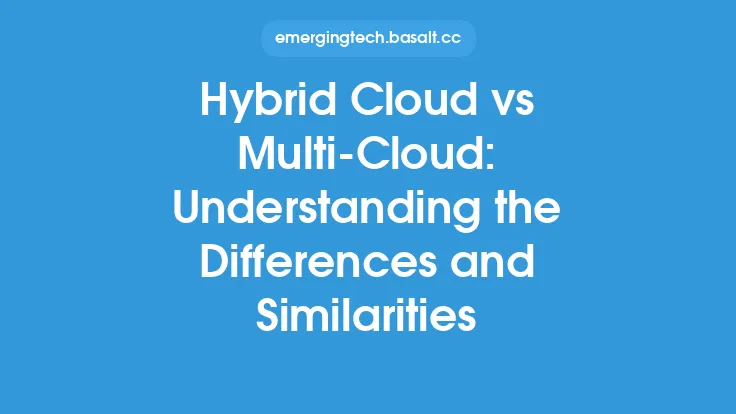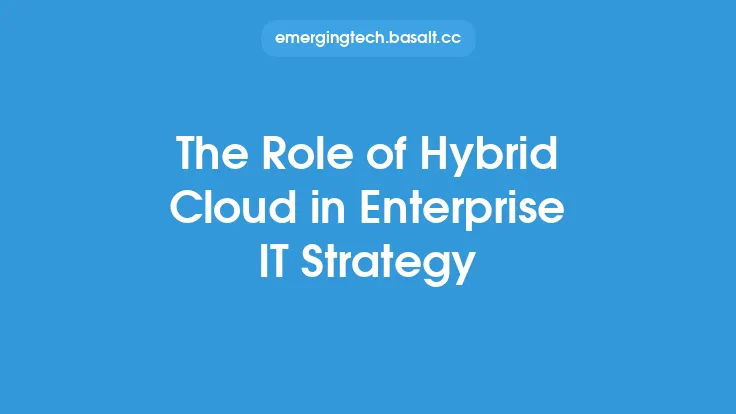When it comes to deploying a hybrid cloud, organizations have a variety of models to choose from, each with its own strengths and weaknesses. The right approach will depend on a number of factors, including the organization's specific needs, the type of applications and data involved, and the level of control and security required. In this article, we'll take a closer look at the different hybrid cloud deployment models available, and provide guidance on how to choose the right one for your organization.
Introduction to Hybrid Cloud Deployment Models
Hybrid cloud deployment models are designed to provide organizations with the flexibility and scalability they need to meet their changing business requirements. These models combine the benefits of public and private clouds, allowing organizations to take advantage of the scalability and cost-effectiveness of public clouds, while also maintaining control and security over their most sensitive data and applications. There are several different hybrid cloud deployment models to choose from, including cloud-based, on-premises, and co-located models.
Cloud-Based Hybrid Cloud Deployment Model
The cloud-based hybrid cloud deployment model involves deploying a hybrid cloud environment that is fully managed and hosted by a cloud service provider. This model is ideal for organizations that want to take advantage of the scalability and cost-effectiveness of the cloud, without having to manage the underlying infrastructure. With a cloud-based hybrid cloud deployment model, the cloud service provider is responsible for managing the cloud infrastructure, including the network, storage, and compute resources. This model is often used by organizations that have a large number of cloud-based applications and services, and want to be able to easily scale up or down to meet changing business requirements.
On-Premises Hybrid Cloud Deployment Model
The on-premises hybrid cloud deployment model involves deploying a hybrid cloud environment that is hosted and managed on-premises, within the organization's own data center. This model is ideal for organizations that have sensitive data and applications that require a high level of control and security. With an on-premises hybrid cloud deployment model, the organization is responsible for managing the underlying infrastructure, including the network, storage, and compute resources. This model is often used by organizations that have a large number of legacy applications and services, and want to be able to maintain control and security over their data and applications.
Co-Located Hybrid Cloud Deployment Model
The co-located hybrid cloud deployment model involves deploying a hybrid cloud environment that is hosted and managed in a co-location facility. This model is ideal for organizations that want to take advantage of the scalability and cost-effectiveness of the cloud, while also maintaining control and security over their most sensitive data and applications. With a co-located hybrid cloud deployment model, the organization is responsible for managing the underlying infrastructure, including the network, storage, and compute resources, but the infrastructure is hosted in a co-location facility. This model is often used by organizations that have a large number of cloud-based applications and services, and want to be able to easily scale up or down to meet changing business requirements.
Factors to Consider When Choosing a Hybrid Cloud Deployment Model
When choosing a hybrid cloud deployment model, there are a number of factors to consider. These include the type of applications and data involved, the level of control and security required, and the scalability and cost-effectiveness of the model. Organizations should also consider their existing infrastructure and resources, as well as their future business requirements. Additionally, organizations should consider the level of support and management required, as well as the level of complexity and risk associated with the model.
Security Considerations for Hybrid Cloud Deployment Models
Security is a critical consideration for hybrid cloud deployment models. Organizations must ensure that their data and applications are protected from unauthorized access and cyber threats. This includes implementing robust security measures, such as firewalls, intrusion detection and prevention systems, and encryption. Organizations should also ensure that their hybrid cloud deployment model is compliant with relevant regulatory requirements, such as HIPAA and PCI-DSS. Additionally, organizations should consider implementing a cloud security gateway, which can provide an additional layer of security and control over cloud-based applications and data.
Management and Orchestration of Hybrid Cloud Deployment Models
Management and orchestration are critical components of hybrid cloud deployment models. Organizations must be able to manage and orchestrate their hybrid cloud environment, including the underlying infrastructure, applications, and data. This includes implementing management and orchestration tools, such as cloud management platforms and IT service management systems. Organizations should also consider implementing automation and orchestration tools, which can help to streamline and optimize hybrid cloud operations. Additionally, organizations should consider implementing monitoring and analytics tools, which can provide real-time visibility and insights into hybrid cloud performance and operations.
Conclusion
In conclusion, hybrid cloud deployment models offer organizations a flexible and scalable way to meet their changing business requirements. By choosing the right hybrid cloud deployment model, organizations can take advantage of the benefits of public and private clouds, while also maintaining control and security over their most sensitive data and applications. When choosing a hybrid cloud deployment model, organizations should consider a number of factors, including the type of applications and data involved, the level of control and security required, and the scalability and cost-effectiveness of the model. By carefully evaluating these factors and considering the security, management, and orchestration requirements of their hybrid cloud environment, organizations can ensure a successful and effective hybrid cloud deployment.





